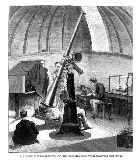Multimedia Content

Astronomers at the Melbourne Observatory observing the Transit of Venus, December 1874., by Samuel Calvert, courtesy of State Library of Victoria.
Details
Astronomy
Systematic astronomical work began in Melbourne with the founding of the Williamstown Observatory in 1853. The Melbourne Observatory, from its foundation in 1863 to its closure in 1944, dominated the local astronomical scene. Melbourne's only other observatories have been small private ventures established by amateur enthusiasts. Spectacular astronomical events - a large comet in 1853, successive reappearances of Halley's comet in 1910 and 1986, the advent in 1957 of Sputnik, the first artificial satellite - have always attracted public interest. A Planetarium, first installed at the museum in 1965 and now located at the Scienceworks museum, helps cater to such interest. Spreading city lights have, however, made serious observing increasingly difficult.
The first telescopes at the Williamstown Observatory were small transit instruments used to provide the local time service. In due course, a program was commenced of accurately determining stellar positions, the southern sky being still at this time mostly unrecorded. The Melbourne Observatory took over both the instruments and the observing programs. Highly regarded catalogues of stellar positions, published in 1869, 1874 and 1889, were the Observatory's major contribution to astronomy.
In 1868 the Observatory acquired a 48-inch (1.2 m) reflector, the Great Melbourne Telescope, to undertake a survey of southern hemisphere nebulae to complement one already undertaken in the north. Among the largest operating telescopes in the world at the time it was installed, this proved not readily adaptable to other tasks.
Internationally, astronomy was transformed in the last decades of the 19th and the first decades of the 20th century, with the rise of astrophysics as an exciting new field of investigation. The Melbourne Observatory, however, never became engaged in astrophysical research of any significance, remaining committed to old-style positional astronomy.
There has never been a separate astronomy department at any of the city's universities, and the subject has only ever been supported as a relatively minor component of university programs in physics. A specialist section for physics, astronomy and mathematics functioned intermittently within the Royal Society of Victoria for a few years from 1879. It revived in the mid-1920s but proved even more short-lived. A Victorian branch of the British Astronomical Association was formed in 1897 but lasted only until 1905. In each case, Melbourne Observatory staff played a leading role, but most of the members were amateurs, few of whom were prepared to commit themselves to the systematic observing programs pressed upon them by their professional colleagues. The Astronomical Society of Victoria, founded in 1922, has proved more enduring and provides mutual support and encouragement for local enthusiasts.
